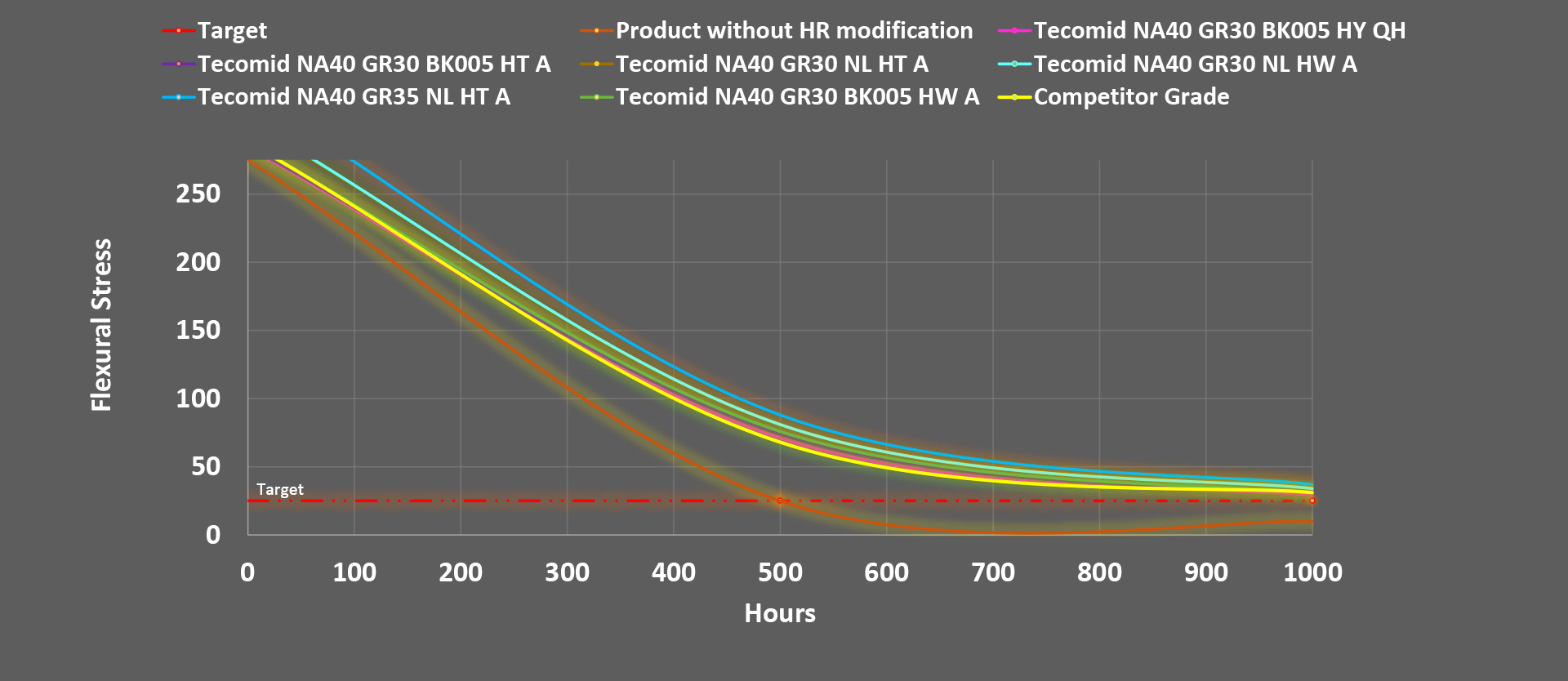Right Material Selection for Automotive Cooling Systems

Right Material Selection for Automotive Cooling Systems
Polyamide-based engineering plastics are widely preferred in underhood and cooling system applications across the automotive industry for their high heat, hydrolysis and oil resistance properties. The properties of these materials should be enhanced and improved for resistance by special formulations so that they meet the requirements of automotive specifications. eurotecoffers its customers a material portfolio consistent with OEM specifications thanks to the right application-right material selection.
The superior mechanical properties, stipulated by OEM specifications for underhood applications such as engine cooling systems and drivetrains in conventional internal combustion vehicles, require the use of materials that are highly heat and hydrolysis resistant. Functional components are used in underhood applications considering their mechanical and thermal properties of such applications. That is why materials that pass long-term resistance tests are preferred. eurotecoffers a wide range of technical polyamide engineering plastics with advanced mechanical and thermal properties as intended for the automotive industry.
eurotecAutomotive Series A
|
|
HS A |
HT A |
HW A |
HY A |
CE A |
|
Color |
Colorless |
Colorless |
Colorless |
Brown |
Colorless |
|
Thermal Resistance <150°C |
+ |
+ |
+ |
+ |
+ |
|
Thermal Resistance >150℃ |
- |
++ |
+ |
+ |
- |
|
Hydrolysis and Oil Resistance |
- |
++ |
+ |
++ |
- |
|
Air Conditioning and UV Resistance Performance |
- |
- |
- |
- |
++ |
|
Electrical Properties |
++ |
- |
+ |
++ |
++ |
Ethylene glycol is used as the cooling water which provides the removal of heat from the environment in applications such as radiator end tanks, cooling pipes, oil filters, throttle caps and expansion tanks. The most crucial parameter to consider when selecting the materials used in these critical components is the component aging in the presence of ethylene glycol at temperatures between 120-140°C. Thus, the proper material selection is the most essential requirement for cooling system applications. PA66 30% fiberglass reinforced products are actively used in applications, such as radiator end tanks, cooling pipes, etc., thanks to their high hydrolysis resistance. eurotec® continues to improve the properties of its product line, using high performance materials conforming with OEM specifications that require hydrolysis resistance at high temperatures for cooling system applications. To analyze the hydrolysis performance of its products, eurotec® collaborated with a German independent testing body which carries out hydrolysis resistance tests for many OEMs. eurotec® series“A”hydrolysis resistant codes were tested at 135°C for 1000 hours at a coolant to water ratio of 50:50 according to VW TL 52682 standard and compared with the commercially known PA66 30% glass fiber reinforced competitor hydrolysis resistant material. The series met the minimum requirement of 25 MPa in 3-point flexural tests.
Hydrolysis Resistance Table

The test is performed at 135ºC with coolant (50:50) according to VW TL 52862.
Along with hydrolysis resistance, there are certain OEM specifications where thermal aging performance is critical for applications requiring resistance to high temperatures such as 150 - 170°C. eurotec® offers its customers high resistance and safe use with the launch of HT A series consisting of the products specially formulated for applications of engine components exposed to high heat and oil resistance throughout their service life.
Emission values have become one of the key parameters in automotive interior applications, and many OEMs have limited these values by standards. PA6 30% glass fiber products are widely used especially in interior applications. The requirements of VW 50180 should be met for emission behaviors of VW group vehicles. eurotec® codes Tecomid® NB40 GR30 NL CE A and Tecomid® NB40 GR30 NL HT A, Tecomid® NB40 GR30 NL HS A and Tecomid® NB40 GR30 BK012 HS A were tested in accordance with VW 50180 for PV 3900 odor characteristics, PV 3015 fogging and PV 3341 emission of organic compounds by an accredited test laboratory in Germany, and met the requirements of VW 50180.
Additionally, electric vehicles have gained momentum as the rising trend in the automotive industry in recent years. While high thermal resistance is crucial to vehicles with internal combustion engines, the temperature gap in the battery pack should be kept at minimum level while driving electric vehicles particularly for battery cooling systems. An electric engine drives its power from control units powered by the battery. Maintaining the battery temperature within the defined minimum-maximum operating temperature range is one of the most critical points regarding the battery life. Thus, the highly efficient operation of an appropriate cooling system is also vital to electric vehicles.
The injection and molding processes for the design of complex components featured in cooling systems use water- or gas-assisted injection molding as well as conventional processes. The particular advantages of water-assisted injection systems (WIT), such as less cycle time, even wall thickness, and superior surface quality, provide ease of design even for parts of thin thickness.
For use in battery cooling systems, eurotec® has developed a material compatible with WIT systems, which stands 130 °C temperature and has improved hydrolysis and glycol resistance. Tecomid® NB60 KG30 BK005 HV 0B (PA6, 30% glass fiber/glass bead reinforced, heat stabilized, black) is readily available for use in cooling pipe applications thanks to its superior surface quality and dimensional stability. Tecomid® NB60 KG30 BK005 HV 0B has passed both 120 °C hydraulic oil tests stipulated by OEM material specifications and leakage, burst, cold impact and pressure pulse tests conducted on the final component. With Tecomid NG60 KG30 BK005 HY 0B A featuring PA66 materials, eurotec also offers new solutions for WIT applications. Thermal conducting codes are outstanding for passive cooling systems. For battery cooling systems, eurotec® developed Tecolen® HP50 NL TC 5C with a thermal conductivity of 5.5 W/m.K, and CTI behavior when above 800V.